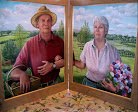This has been an extraordinary year. The soft fruit has been magnificent, and for once the birds have largely left it alone. We have feasted on strawberries, redcurrants, raspberries, tayberries, and the blackcurrant bushes are laden with huge berries waiting to be picked. Susanna has tried her hand at making redcurrant jelly, a must for lamb, and raspberry vinegar, such a refreshing summer drink. Though the birds did strip the morello cherry last weekend when we were away in Louth with the Irish Tree Society. I would like to think that the birds are learning to share, though I fear it may have more to do with so many dying in the last hard winter.
We are eating our own peas and beans, with more coming on in succession, and I am very pleased with the new potatoes - Duke of York now, with Charlotte and Pink Fir Apple to follow on. Courgettes threaten to become a glut. Only the tomotoes and cucumbers in the poly-tunnel are a disappointment - probably because the plastic is losing its transparency.
The roses have also been very good this year, no doubt because the frost reduced the numbers of pests and the dry June held back the mildew.
But the stars of the season are the day lilies. Susanna bought an extensive collection from the specialist Apple Court Nursery in England some years ago, which have been moved to her Labyrinth garden in front of the house, where they have really taken off. The sheer variety of form and colour is quite extraordinary. All this has been achieved by nursery men, largely in the USA - but it is the hand of God which has made the variation in the wild species without which they could have done nothing!
Below you will find portraits of most of the cultivars, varying in colour from lemon yellow through peach and pink to strong reds, and varying in form from delicate elongated to full and plump. Unfortunately the labels got lost when they were transplanted, and we can no longer identify which is which.




















No comments:
Post a Comment